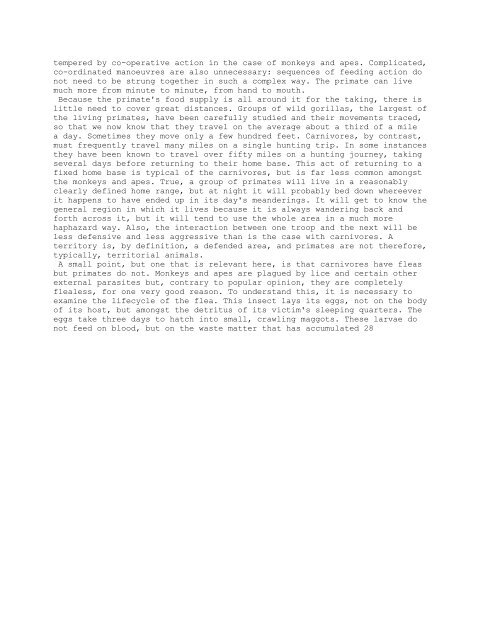Create successful ePaper yourself
Turn your PDF publications into a flip-book with our unique Google optimized e-Paper software.
tempered by co-operative action in the case of monkeys and apes. Complicated,<br />
co-ordinated manoeuvres are also unnecessary: sequences of feeding action do<br />
not need to be strung together in such a complex way. The primate can live<br />
much more from minute to minute, from hand to mouth.<br />
Because the primate's food supply is all around it for the taking, there is<br />
little need to cover great distances. Groups of wild gorillas, the largest of<br />
the living primates, have been carefully studied and their movements traced,<br />
so that we now know that they travel on the average about a third of a mile<br />
a day. Sometimes they move only a few hundred feet. Carnivores, by contrast,<br />
must frequently travel many miles on a single hunting trip. In some instances<br />
they have been known to travel over fifty miles on a hunting journey, taking<br />
several days before returning to their home base. This act of returning to a<br />
fixed home base is typical of the carnivores, but is far less common amongst<br />
the monkeys and apes. True, a group of primates will live in a reasonably<br />
clearly defined home range, but at night it will probably bed down whereever<br />
it happens to have ended up in its day's meanderings. It will get to know the<br />
general region in which it lives because it is always wandering back and<br />
forth across it, but it will tend to use the whole area in a much more<br />
haphazard way. Also, the interaction between one troop and the next will be<br />
less defensive and less aggressive than is the case with carnivores. A<br />
territory is, by definition, a defended area, and primates are not therefore,<br />
typically, territorial animals.<br />
A small point, but one that is relevant here, is that carnivores have fleas<br />
but primates do not. Monkeys and apes are plagued by lice and certain other<br />
external parasites but, contrary to popular opinion, they are completely<br />
flealess, for one very good reason. To understand this, it is necessary to<br />
examine the lifecycle of the flea. This insect lays its eggs, not on the body<br />
of its host, but amongst the detritus of its victim's sleeping quarters. The<br />
eggs take three days to hatch into small, crawling maggots. These larvae do<br />
not feed on blood, but on the waste matter that has accumulated 28








